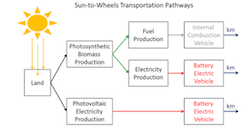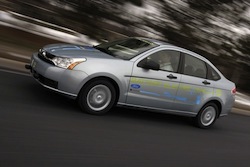How does energy produced by the sun (solar) compete with ethanol in terms of land use, life-cycle emissions and cost? These questions are being asked by University of California Santa Barbara (UCSB) Bren School of Environmental Science & Management Professor Roland Geyer. He wants to know what makes more sense, growing fuel crops to supply alternative-fuel vehicles with ethanol or other biofuels or using photovoltaics (PV) to directly power battery electric vehicles (EVs).
 “The energy source for biofuels is the sun, through photosynthesis,” explains Geyer. “The energy source for solar power is also the sun. Which is better?”
“The energy source for biofuels is the sun, through photosynthesis,” explains Geyer. “The energy source for solar power is also the sun. Which is better?”
To find out, Geyer joined former BrenSchool researcher David Stoms and James Kallaos, of the Norwegian University of Science and Technology, to model the relative efficiencies of the technologies at converting a given amount of sunlight to miles driven. The results have been published in the paper, “Spatially Explicit Life Cycle Assessment of Sun-to-Wheels Transportation Pathways in the U.S.,” in the Dec. 26 issue of the journal Environmental Science & Technology. Results showed photovoltaics (PV) to be much more efficient than biomass at turning sunlight into energy to fuel a car.
“PV is orders of magnitude more efficient than biofuels pathways in terms of land use — 30, 50, even 200 times more efficient — depending on the specific crop and local conditions,” said Geyer. “You get the same amount of energy using much less land, and PV doesn’t require farm land.”
The researchers examined three ways of using sunlight to power cars: 1) the traditional method of converting corn or other plants to ethanol; 2) converting energy crops into electricity for BEVs rather than producing ethanol; and 3) using PVs to convert sunlight directly into electricity for EVs. Because land-use decisions are local, Geyer explained, he and his colleagues examined five prominent “sun-to-wheels” energy conversion pathways — ethanol from corn or switchgrass for internal combustion vehicles, electricity from corn or switchgrass for EVs, and PV electricity for EVs — for every county in the contiguous United States.
Focusing the life cycle assessments on three key impacts — direct land use, life cycle greenhouse gas (GHG) emissions, and fossil fuel requirements — the researchers identified PV electricity for battery electric vehicles as the superior sun-to-wheels conversion method.
 “Even the most efficient biomass-based pathway requires 29 times more land than the PV-based alternative in the same locations,” wrote the authors. “PV BEV systems also have the lowest life-cycle GHG emissions throughout the U.S. and the lowest fossil fuel inputs, except in locations that have very high hypothetical switchgrass yields of 16 or more tons per hectare.”
“Even the most efficient biomass-based pathway requires 29 times more land than the PV-based alternative in the same locations,” wrote the authors. “PV BEV systems also have the lowest life-cycle GHG emissions throughout the U.S. and the lowest fossil fuel inputs, except in locations that have very high hypothetical switchgrass yields of 16 or more tons per hectare.”
According to the research, PV conversion also has lower greenhouse gas emissions throughout the life cycle than do cellulosic biofuels, even in the most optimistic scenario for the latter. “The bottleneck for biofuels is photosynthesis,” said Geyer. “It’s at best 1-percent efficient at converting sunlight to crop, while today’s thin-film PV is at least 10-percent efficient at converting sunlight to electricity.
Finally, while cost was not a key component of the study, Geyer said the cost of solar power is dropping, and quick calculations suggests that with the federal tax credit, electric vehicles are already competitive.
What does this mean for the future?
“What it says to me is that by continuing to throw money into biofuels, we’re barking up the wrong tree,” explained Geyer. “That’s because of a fundamental constraint, which is the relative inefficiency of photosynthesis. And we can’t say that right now, biofuels aren’t so great but they’ll be better in five years. That fundamental problem for biofuels will not go away, while solar EVs will just continue to get more efficient and cheaper. If they’re already looking better than biofuels, in five years the gap will be even greater. A search for a silver bullet is under way through “synthetic photosynthesis,” but using genetic engineering to improve the efficiency of photosynthesis is a pipe dream. If there is a silver bullet in energy, I think it’s solar power.”

